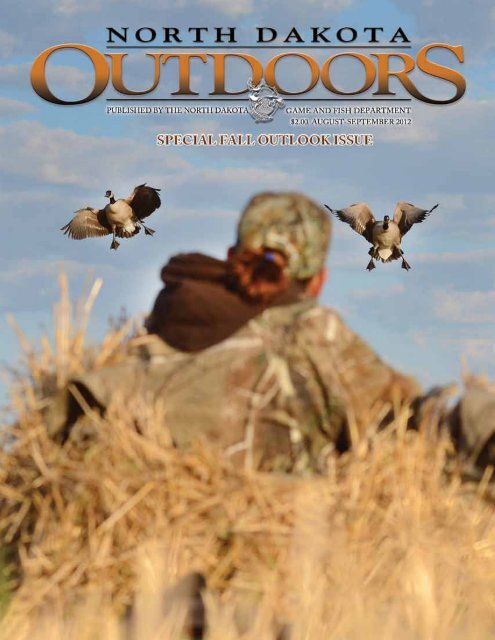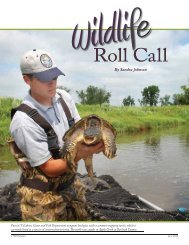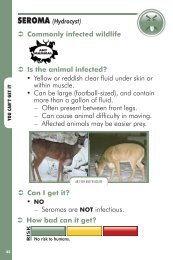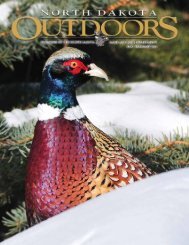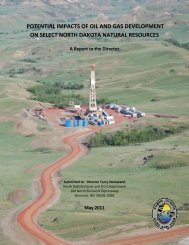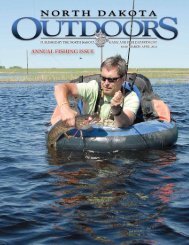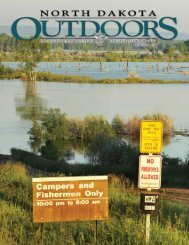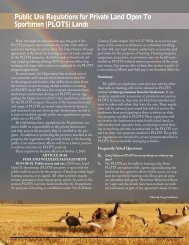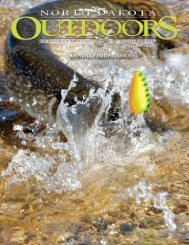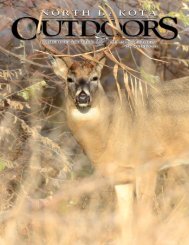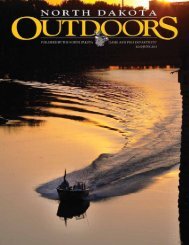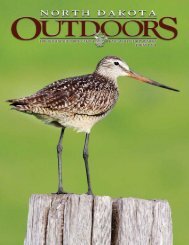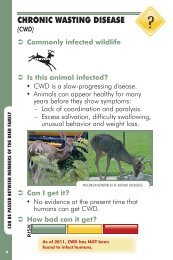North Dakota Outdoors Magazine August-September 2012 ...
North Dakota Outdoors Magazine August-September 2012 ...
North Dakota Outdoors Magazine August-September 2012 ...
- No tags were found...
Create successful ePaper yourself
Turn your PDF publications into a flip-book with our unique Google optimized e-Paper software.
MATTERS OF OPINIONTerry SteinwandDirectorIt must be a sign of getting older, but Ihave no idea where summer has gone. I’veonly accomplished about half of what Iintended, and that might be an exaggeration.Of course, now we’re heading into fall,and hunters in <strong>North</strong> <strong>Dakota</strong> have alreadytaken to the field. Early Canada goose seasonopened <strong>August</strong> 15 and from reports I’vereceived, hunting has been great and a lot offolks are taking advantage of this opportunity.It’s been a few years since I hunted duringthe early goose season. I remember my firstexperience, sitting in a harvested wheat fieldamongst a few decoys, sweating and gettingchewed up by mosquitoes, wondering what I’dgotten myself into.Yet, given the brisk mornings of late<strong>August</strong>, the juices started to flow again andI’m thinking I should go out and give itanother try.I’ve often said that fall is a time of decisionin <strong>North</strong> <strong>Dakota</strong>. Numerous hunting seasonsstart to show up on the calendar and fishingis typically fantastic. From all the informationI’ve received from Game and Fish Departmentsurveys, and from talking with peopleacross the state, it should be another goodyear.The ring-necked pheasant population looksto be in good shape, with preliminary reportsshowing pheasant numbers might be the bestsince 2008. The recent mild winter, followedby one of the better hatching and rearingperiods in a long time, have greatly contributedto that positive report. In addition, westill have decent habitat conditions that allowwildlife to survive.As those conditions change, however, sowill the ability of wildlife to bounce backfrom bad weather.While pheasants, ducks and geese are all upfrom last year, not all populations are doingas well as we’d like. The sage grouse, prairiechicken and pronghorn seasons will remainclosed this year, and of course our deer populationsin most areas are well below wherethey were five years ago.Still, the opportunities are almost endlessif you want to get out and enjoy what <strong>North</strong><strong>Dakota</strong> offers. Just think about our optionsas fall creeps nearer. Hunting for sharp-tailedgrouse, ducks and geese, pheasants, deer witha bow or gun, and then there’s fall fishing.What a list to choose from.I don’t know how everyone else views thetransition from summer to fall, but I lookforward to it every year. I enjoy the crispmornings and the anticipation of getting outand enjoying <strong>North</strong> <strong>Dakota</strong>’s fish and wildliferesources. I encourage you to do the same.
DEPARTMENT DIRECTORYGovernor Jack DalrympleADMINISTRATIVE DIVISIONGame and Fish Director: Terry SteinwandChief, Administrative Services: Kim MolesworthBusiness Manager: Corey WentlandAdministrative Assistant: Geralyn M. EvansAdministrative Officer/Building Maint. Supvr: George LeeBuilding Maint. Tech: Dustin RepnowChief Accountant: Angie KruegerAccountants: Kelly Wike, Melissa Long, Ashley BakerIT Section Supervisor/GIS Specialist: Brian HosekIT Coordinators: Sally Sorenson, Alan ReileProgrammer Analyst: Tiffany QuastLicensing Manager: Randy MeissnerAssistants: Gail Mosset, Katherine Mernitz, Janet Wolf, Amanda AnstromAdministrative Assistant – Dickinson: Janel Kolar, Stephanie RichardsonAdministrative Assistant – Devils Lake: Lisa TofteAdministrative Assistant – Jamestown: Tonya KukowskiAdministrative Assistant – Riverdale: Clare RennerCONSERVATION AND COMMUNICATIONS DIVISIONDivision Chief: Greg Link, BismarckAdministrative and Water Safety Coordinator: Nancy Boldt, BismarckCommunications Supervisor: Craig Bihrle, BismarckEditor, <strong>North</strong> <strong>Dakota</strong> OUTDOORS: Ron Wilson, BismarckWebsite Editor: Pat Headrick, BismarckNews Editor: Greg Freeman, BismarckVideo News Director: Tom Jensen, BismarckVideographer: Mike Anderson, BismarckInformation Specialist: Dawn Jochim, BismarckGraphic Artist: Connie Schiff, BismarckOutreach Supervisor: Chris D. Grondahl, BismarckOutreach Biologists: Doug Leier, West Fargo; Greg Gullickson, Minot; MartyEgeland, Grand Forks; Pat Lothspeich, BismarckEducation Coordinator: Jeff Long, BismarckHunter Education Coordinator: Zach PetersonConservation Supervisor: Steve Dyke, BismarckResource Biologists: Alexis Duxbury, John Schumacher, Bruce Kreft, BismarckConservation Biologists: Sandra Johnson, Patrick Isakson, BismarckENFORCEMENT DIVISIONDivision Chief: Robert Timian, BismarckInvestigations Supvr: Bruce Burkett, BismarckInvestigator: Scott Winkelman, BismarckRegion No. 1 Warden Supvr: Corey Erck, Jamestown.District Wardens: Jackie Lundstrom, Bismarck; Amy Jo Winkelman, Bismarck;Jerad Bluem, Steele; Mark Pollert, Jamestown; Michael Sedlacek, Fargo; Tim Phalen,Wyndmere; Andrew Dahlgren, Edgeley; Erik Schmidt, LintonRegion No. 2 Warden Supvr: Paul Freeman, Devils LakeDistrict Wardens: Jonathan Tofteland, Bottineau; Randy Knain, Rugby; Kurt Aufforth,Cando; Greg Hastings, Cavalier; Gary Rankin, Larimore; Jim Job, Devils Lake;James Myhre, New RockfordRegion No. 3 Warden Supvr: Doug Olson, Riverdale.District Wardens: Jim Burud, Kenmare; Al Howard, Minot; Tim Larson, TurtleLake; Ken Skuza, Riverdale; Michael Raasakka, Stanley; Brent Schwan, Watford CityRegion No. 4 Warden Supvr: Dan Hoenke, DickinsonDistrict Wardens: Ryan Tunge, Hazen; Bill Schaller, Killdeer; Art Cox, Bowman;Courtney Sprenger, Elgin; Jeff Violett, MandanAdministrative Assistant: Lori Kensington, BismarckWILDLIFE DIVISIONDivision Chief: Randy Kreil, BismarckAssistant Division Chief: Jeb Williams, BismarckGame Mgt. Section Leader: Michael A. Johnson, BismarckProcurement Officer: Ray Parsons, BismarckPilot: Jeff Faught, BismarckUpland Game Mgt. Supvr: Stan Kohn, BismarckUpland Game Mgt. Biologist: Aaron Robinson, DickinsonMigratory Game Bird Biologist: Mike Szymanski, BismarckBig Game Mgt. Supvr: Bruce Stillings, DickinsonBig Game Mgt. Biologists: Bill Jensen, Bismarck; Brett Wiedmann, Dickinson,Jason Smith, JamestownSurvey Coordinator: Jerry GulkeWildlife Veterinarian: Dr. Daniel Grove, BismarckFurbearer Biologist: Stephanie Tucker, BismarckGame Management Technician: Rodney Gross, Devils LakeWildlife Resource Management Section Leader: Scott Peterson, LonetreeWildlife Resource Mgt. Supvrs: Bill Haase, Bismarck; Brian Prince, Devils Lake; KentLuttschwager, Williston; Brian Kietzman, Jamestown; Dan Halstead, RiverdaleWildlife Resource Mgt. Biologists: Arvid Anderson, Riverdale; Randy Littlefield,Lonetree; Rodd Compson, Jamestown; Judd Jasmer, DickinsonWildlife Techs: Tom Crutchfield, Jim Houston, Bismarck; Dan Morman, RobertMiller, Riverdale; Ernest Dawson, Jamestown; Morgan Johnson, Seth Gaugler,Lonetree; Alan Roller, Williston; Scott Olson, Devils LakePrivate Land Section Leader: Kevin Kading, BismarckAsst. Private Land Coordinator: Doug Howie, BismarckPrivate Land Field Operation Coordinator: Casey Anderson, BismarckPrivate Land Biologists: Jon Roaldson, Colin Penner, Terry Oswald, Jr., Levi Jacobson,Bismarck; Ty Dressler, Dickinson; Ryan Huber, Riverdale; Nathan Harling, DevilsLake; Renae Heinle, Jamestown; Todd Buckley, WillistonAdministrative Assistant: Dale Repnow, BismarckLonetree Administrative Assistant: Diana Raugust, HarveyFISHERIES DIVISIONDivision Chief: Greg Power, BismarckFisheries Mgt. Section Leader: Scott Gangl, BismarckFisheries Supvrs: Fred Ryckman, Riverdale; Jeff Hendrickson, Dickinson; Jason Lee,Riverdale; Paul Bailey, Bismarck; Randy Hiltner, Devils Lake; Gene Van Eeckhout,Jamestown; Dave Fryda, RiverdaleFisheries Biologists: Brandon Kratz, Jamestown; Russ Kinzler, Riverdale, ToddCaspers, Devils LakeFisheries Techs: Shane Shefstad, Williston; Phil Miller, Devils Lake; Pat John,Jamestown; Justen Barstad, Bismarck; Brian Frohlich, Riverdale; Jeff Merchant,DickinsonProduction/Development Section Supvr: Jerry Weigel, BismarckAquatic Habitat Supvr: Scott Elstad, BismarckFisheries Development Supvr: Bob Frohlich, BismarckFisheries Dev. Proj. Mgr: Wesley Erdle, BismarckFisheries Development Technician: Kyle Hoge, BismarckAdministrative Assistant: Janice Vetter, BismarckADVISORY BOARDDistrict 1 ................................................................................Jason Leiseth, ArnegardDistrict 2 ..............................................................................Robert Gjellstad, VoltaireDistrict 3 ............................................................................ Thomas Rost, Devils LakeDistrict 4 ..................................................................................Ronald Houdek, TolnaDistrict 5 .............................................................................. Loran Palmer, WahpetonDistrict 6 ........................................................................ Joel Christoferson, LitchvilleDistrict 7 ................................................................................ Frank Kartch, BismarckDistrict 8 .............................................................................. Dwight Hecker, FairfieldThe mission of the <strong>North</strong> <strong>Dakota</strong> Game and Fish Department is to protect, conserve and enhance fish andwildlife populations and their habitats for sustained public consumptive and nonconsumptive use.Editor: Ron Wilson Graphic Designer: Connie Schiff Circulation Manager: Dawn JochimAUGUST-SEPTEMBER <strong>2012</strong> • NUMBER 2 • VOLUME LXXVTABLE OF CONTENTSFEATURES<strong>2012</strong> Hunting Outlook........................................................................................................ 2PLOTS Then and Now...................................................................................................... 18First Time Field Hunt Photo Essay................................................................................... 20DEPARTMENTSBuffaloberry Patch.............................................................................................................. 26Back Cast........................................................................................................................... 33<strong>North</strong> <strong>Dakota</strong> OUTDOORS is published 10 times a year, monthly except for the months of Apriland <strong>September</strong>. Subscription rates are $10 for one year or $20 for three years. Group rates of $7 ayear are available to organizations presenting 25 or more subscriptions. Remittance should be bycheck or money order payable to the <strong>North</strong> <strong>Dakota</strong> Game and Fish Department. Indicate if subscriptionis new or renewal. The numbers on the upper right corner of the mailing label indicate thedate of the last issue a subscriber will receive unless the subscription is renewed.Permission to reprint materials appearing in <strong>North</strong> <strong>Dakota</strong> OUTDOORS must be obtained fromthe author, artist or photographer. We encourage contributions; contact the editor for writer andphotography guidelines prior to submission.The NDGFD receives federal financial assistance from the U.S. Fish and Wildlife Service. Inaccordance with Title VI of the Civil Rights Act of 1964, Section 504 of the Rehabilitation Act of1973, Title II of the Americans with Disabilities Act of 1990, the Age Discrimination Act of 1975,and Title IX of the Education Amendments of 1972, the NDGFD joins the U.S. Department ofthe Interior and its bureaus in prohibiting discrimination on the basis of race, color, national origin,age, disability, sex (in education programs or activities) and also religion for the NDGFD. If youbelieve you have been discriminated against in any program, activity, or facility as described above,or you desire further information, please write to: N. D. Game and Fish Department, Attn: ChiefAdministrative Services, 100 N. Bismarck Expressway, Bismarck, ND 58501-5095 or to: U.S. Fishand Wildlife Service, Attn: Civil Rights Coordinator, 4401 N. Fairfax Drive, Mail Stop: MBSP-4020, Arlington,Virginia 22203.Periodical Postage Paid atBismarck, ND 58501and additional entry offices.Printed in the United StatesFront CoverThe final approach by geese or ducks committed toa decoy set is a highlight moment of any waterfowlhunt. See more images from this successful dayafield starting on page 20.Photo by Craig Bihrle, BismarckOfficial Publication of the <strong>North</strong> <strong>Dakota</strong> Game and Fish Department (ISSN 0029-2761)100 N. Bismarck Expressway, Bismarck, ND 58501-5095Website: gf.nd.gov • email: ndgf@nd.govInformation (701) 328-6300 • Administration (701) 328-6305Hunter Education (701) 328-6615 • Licensing (701) 328-633524-Hour Licensing by Phone: (800) 406-6409The TTY/TTD (Relay ND) number for the hearing or speech impaired is (800) 366-6888POSTMASTER: Send address changes to:<strong>North</strong> <strong>Dakota</strong> OUTDOORS100 <strong>North</strong> Bismarck ExpresswayBismarck, ND 58501-5095Report All Poachers (RAP) 800-472-2121In cooperation with <strong>North</strong> <strong>Dakota</strong> Wildlife Federation and <strong>North</strong> <strong>Dakota</strong> State Radio.
<strong>2012</strong> HUNTINThe forecast for <strong>2012</strong> calls for <strong>North</strong> <strong>Dakota</strong>’s contribution to thecontinental duck fall flight to be about twice that of last year.2 ND <strong>Outdoors</strong> <strong>August</strong>-<strong>September</strong> <strong>2012</strong>
G OUTLOOKA PERIOD OF UNCERTAINTYBy Randy KreilChoosing a theme for the <strong>2012</strong> hunting outlook was difficult. We have excellent prospects forducks and geese, and a somewhat surprisingly good forecast for pheasants.On the other hand, for the third straight year <strong>North</strong> <strong>Dakota</strong> won’t have a pronghornseason, and deer license numbers are the lowest in 20 years.CRAIG BIHRLE<strong>August</strong>-<strong>September</strong> <strong>2012</strong> ND <strong>Outdoors</strong> 3
These extremes are easily identifiedby looking at statistics, but other factorsthat influence any fall hunting seasonare less certain.As we know, the prairies of the<strong>North</strong>ern Plains almost define theterm uncertainty because of the everchangingweather and dynamic naturalecosystems. Add in a hotly debatednational farm policy and this unpredictablemixture has always had a significantimpact on wildlife populations andhunting opportunities.We’ve seen hopeful signs that wildlifepopulations might rebound from threetough winters.Female deer and pronghorn exitedwinter in good shape and should haveproduced a good fawn crop, whichis essential in helping populationsrebound. Upland game species alsolikely experienced little winter mortalityand spring populations were in goodshape.The nesting and brood-rearing periodin late spring and early summer weremild and likely beneficial to uplandgame.For ducks, spring water conditionswere adequate, upland nesting habitatsufficient and waterfowl pair counts andsummer brood counts were high.However, the continuing loss ofhabitat from an upswing in the conversionof native prairie to crop fields, theimpending loss of more than 650,000acres of CRP this fall, the hot and drysummer conditions that will shrink ordry wetlands, may create some challengesfor hunters this fall.With upland game and waterfowlpopulations in good shape, large numbersof resident and nonresident hunterswill take to the field, but <strong>North</strong> <strong>Dakota</strong>will have fewer acres available to huntthis fall. That could mean more crowdedconditions in some places.While waterfowl hunters will enjoygood bird numbers, finding huntingspots over water and in fields will be achallenge due to lower water levels andfewer acres of small grains resultingfrom changing cropping practices.The future is uncertain as well.Should we experience a return tomore typical <strong>North</strong> <strong>Dakota</strong> winters,existing wildlife populations will behampered in their ability to rebound,with less habitat of lower quality on thelandscape.This fall will be decent for hunters in<strong>North</strong> <strong>Dakota</strong>. However, there is a lotof uncertainty about what will happenwith wildlife habitat down the road.Always hopeful, we will continueto work with landowners, hunters andother conservation organizations tosalvage and maintain habitat friendlyprograms and policies, to develop amore certain future than exists today.RANDY KREIL is the Game and FishDepartment’s wildlife division chief.A mild winter in <strong>2012</strong> is expected tohelp deer populations rebound acrossmuch of the state.CRAIG BIHRLE4 ND <strong>Outdoors</strong> <strong>August</strong>-<strong>September</strong> <strong>2012</strong>
UPLANDAND SMALL GAMEThere are some positive signs in thepheasant world, pointing to thepossibility of better than normalproduction statewide.nesting and brooding were quite goodacross the state, which could mean betterthan normal production statewide.Game and Fish Department roadsidebrood counts in late summer will providea better estimate of production anda more definitive preview of this fall’spheasant hunting season.Stan Kohn, Upland GameManagement Supervisor, BismarckRING-NECKED PHEASANTSRegular Season Opens: Oct. 13Delayed Opener: Oct. 20Regular Season Closes: Jan. 6, 2013Delayed Season Closes: Jan. 6, 2013Daily Limit: 3Possession Limit: 12Shooting Hours: Half-hour beforesunrise to sunsetBecause habitat and weather playimportant roles in the number ofpheasants hunters see each fall, lastwinter’s mild conditions were a welcomedevelopment, providing a jumpstart forspring breeding.Winters of 2008-11 were hard onpheasants caught in poor cover. Thosewinters were followed by cool, wetconditions during brooding and feweryoung birds were recruited into thefall population. Knowing this, Gameand Fish biologists expected that thisspring’s rooster crowing counts mightbe down, but instead the index was up10 percent statewide from 2011.In 2009-10, the number of pheasanthunters in <strong>North</strong> <strong>Dakota</strong> droppedbelow 100,000, with a harvest of about500,000 or more roosters annually.More hunting opportunities meantmore pheasants taken during the 2011season, as last fall’s pheasant harvestwas 683,000, up from 552,000 in 2010.While the overall landscape probablydidn’t have more birds, Mother Natureallowed for an increase in harvest dueto mild weather and minimal snowcover in November, December and earlyJanuary.Since 2000, hunters have enjoyed fallpheasant numbers like most had neverseen. Unfortunately, birds are losingnesting and brooding habitat with thecontinued decline of ConservationReserve Program acres across much ofthe state, most notably in southeastern<strong>North</strong> <strong>Dakota</strong>.Loss of this critical habitat will surelynegatively influence the pheasant population.Combine this with long, snowywinters and cold, wet weather at hatchingtime, and pheasant numbers decline.As this is written, it’s still too early tomake any predictions about fall numbersand distribution of pheasants, butthere are some positives, including lastwinter’s mild weather, which was goodfor pheasants, especially hens. Habitatconditions and weather during springCRAIG BIHRLEWILD TURKEYSOpens: Oct. 13Closes: Jan. 13, 2013Shooting Hours: Half-hour beforesunrise to sunsetWild turkeys are not native to <strong>North</strong><strong>Dakota</strong>, but they have adapted to ourlimited woodland resources. Even so,winter does pose a problem for birdssince natural woodland foods are scarce.When winter hits in <strong>North</strong> <strong>Dakota</strong>,wild turkeys usually travel to farmsteadsof generous and tolerant landownerswhere food and cover is available. Herethey find the necessities needed tosurvive winter.Turkeys occupy all areas of the stateThe weather was nearly perfect this year fornesting and brooding hens.<strong>August</strong>-<strong>September</strong> <strong>2012</strong> ND <strong>Outdoors</strong> 5CRAIG BIHRLE
Pheasant hunters shot683,000 birds lastseason.containing good habitat. In many instances, they evenbreed and winter in areas not normally considered goodturkey habitat. Like other game birds, poor production andchick recruitment has trimmed the overall population since2008.Almost all hunting units have experienced a decline inturkey numbers, leading to fewer hunting licenses. It’s tooearly to estimate a fall population as some nesting habitatalong the Missouri, Little Missouri and Souris river bottomlandswas disturbed during major flooding last summer.On a positive note, spring habitat conditions in much ofthe state looked quite good and the weather was almostperfect for nesting and brooding hens, likely adding moreyoung birds to the population than the previous three years.Even though license numbers are down in most huntingunits, with some preseason scouting and contacts, huntersshould be able to locate birds along wooded river bottoms,drainages and forested areas.Stan KohnSharp-tailed grouse arenative to <strong>North</strong> <strong>Dakota</strong>.CRAIG BIHRLEMIKE LALONDESHARP-TAILED GROUSEOpens: Sept. 8Closes: Jan. 6, 2013Daily Limit: 3Possession Limit: 12Shooting Hours: Half-hour before sunrise to sunsetUpland game species in <strong>North</strong> <strong>Dakota</strong> declined rapidlyfollowing three difficult winters. Last winter, however, setthe stage for a potential rebound going into the <strong>2012</strong> huntingseason if conditions are favorable for nesting and broodrearing.Most upland game species have the reproductive potentialto recover quickly from drastic reductions caused byweather, but there is a caveat. Recovery depends on thequality of habitat within the species’ home range and ifweather is favorable to allow chicks the opportunity tosurvive.In <strong>North</strong> <strong>Dakota</strong>, quality habitat is being lost as acreageenrolled in the Conservation Reserve Program is removedfrom the landscape. Additionally, fragmentation associatedwith energy development and loss of native prairie arenegatively affecting sharp-tailed grouse populations andother wildlife species.Summer sharptail brood counts, which are the mostaccurate predictor of the fall hunting season, were notconducted by the time of this writing. The data available islast year’s hunter harvest age ratios, which indicated poorproduction in many areas of the state for 2011, and springdancing ground trends, which showed a slight increase thisyear compared to 2011.Neither method can provide an accurate prediction forthis fall’s hunting season so hunters must wait for latersummer brood count reports.6 ND <strong>Outdoors</strong> <strong>August</strong>-<strong>September</strong> <strong>2012</strong>
As a best guess, nesting conditionswere optimal with relatively mildweather across the state. Southwestern<strong>North</strong> <strong>Dakota</strong> is enduring a significantdrought that will reduce insect productionand ultimately affect brood survival.The state’s northern tier had timelyprecipitation, but only time will tell howgrouse respond. Hunters should expectto see slightly increased numbers ofsharp-tailed grouse this hunting season.Aaron Robinson, Upland GameManagement Biologist, DickinsonRUFFED GROUSEOpens: Sept. 8Closes: Jan. 6, 2013Daily Limit: 3Possession Limit: 12Shooting Hours: Half-hour beforesunrise to sunsetRuffed grouse inhabited the nativeaspen woodlands in Rolette, Bottineau,Pembina, Walsh, and Cavalier countiesprior to European colonization. Thesebirds provide an interesting segmentof the <strong>North</strong> <strong>Dakota</strong> landscape, andare our only native woodland grousespecies.More than 40 years of ruffed grousecensus data in <strong>North</strong> <strong>Dakota</strong> shows thatbird numbers tend to cycle about every8-10 years. Even though native foresthabitat continues to shrink, these birdsare doing their best to adapt to what isavailable.Ruffed grouse hunting season dates,bag limits, number of hunters andharvest has remained fairly constantover the last 20 years.In 2010, it seemed wewere slowly movingout of the lowpoint in the populationcycle. However,spring drummingcounts in both 2011and <strong>2012</strong> showed adecrease from 2010.This spring’s drummingcounts weredown 37 percentstatewide from 2011,and dropped 24 percent in the TurtleMountains and almost 42 percent inthe Pembina Hills. In early July, nestingsuccess and production information onruffed grouse were unknown, but even ifthe population is low, it is always enjoyableto hike through <strong>North</strong> <strong>Dakota</strong>’snative woodlands in fall.Stan KohnHUNGARIAN PARTRIDGEOpens: Sept. 8Closes: Jan. 6, 2013Daily Limit: 3Possession Limit: 12Shooting Hours: Half-hour beforesunrise to sunsetThis fall, hunters will likely see slightlyhigher numbers of partridge in the fieldcompared to last year.Spring weather was favorable in manyparts of the state. A string of toughwinters reduced the adult breedingpopulation, but last winter should helpthe population recover heading intonesting season.Pockets of decent hunting may befound in areas where multiple pairsreproduced successfully, but hunters willneed to spend some time in the morningsscouting out potential areas.Aaron RobinsonSAGE GROUSE, PINNATEDGROUSEHunting seasons for sage grouse andpinnated grouse are closed again this fall.Sage grouse have beenslow to rebound insouthwestern <strong>North</strong><strong>Dakota</strong>.CRAIG BIHRLEWhile the number of strutting malesobserved during the spring sage grousesurvey was up 15 percent from last year,showing some hope for a strugglingspecies, the population remains wellbelow management objectives.This is the fifth year in a row that<strong>North</strong> <strong>Dakota</strong> won’t have a sage grouseseason, and the third year in a row forno season on pinnated grouse, or prairiechickens, in the northeastern and southeasternparts of the state.Game and Fish Department biologistscounted 72 male sage grouse in springon 12 active strutting grounds. Last year,63 males were counted on 12 active leksin southwestern <strong>North</strong> <strong>Dakota</strong>.The number of males counted on lekseach spring has gradually declined since2000. In 2008, spring counts droppeddramatically throughout <strong>North</strong> <strong>Dakota</strong>’ssage grouse range due to West Nilevirus.Numerous conservation efforts havetaken place in the past four years whichwill hopefully help the sage grousepopulation recover. Sage grouse managementin <strong>North</strong> <strong>Dakota</strong> and theentire range of 11 western states is acollaborative effort.Sage grouse are <strong>North</strong> <strong>Dakota</strong>’s largestnative upland game bird. They are foundin extreme southwestern <strong>North</strong> <strong>Dakota</strong>,primarily in Bowman and Slope counties.Male prairie chicken spring boomingcounts have dramatically declined inrecent years. Wet conditions in eastern<strong>North</strong> <strong>Dakota</strong> have contributed to poornesting success.TREE SQUIRRELSOpen Area: StatewideOpens: Sept. 8Closes: Jan. 6, 2013Daily Limit: 4Possession Limit: 12Shooting Hours: Half-hour beforesunrise to sunsetTree squirrels may be taken withfirearms loaded with shot, rimfire rifles,or with bow and arrows legal for takingupland game.<strong>August</strong>-<strong>September</strong> <strong>2012</strong> ND <strong>Outdoors</strong> 7
BIGGAMECRAIG BIHRLEDeer licenses for fallwere cut statewide bynearly 45,000. Muchof the reduction camefrom doe licenses.Theregular gun seasonopens November 9.CRAIG BIHRLEWHITE-TAILED DEERArchery Opens: Aug. 31Archery Closes: Jan. 6, 2013Regular Gun Season Opens: Nov. 9Regular Gun Season Closes: Nov. 25Muzzleloader Opens: Nov. 30Muzzleloader Closes: Dec. 16The Game and Fish Department made available 65,300licenses for the regular gun season, which is 44,650 fewerthan 2011. This is the lowest number of deer licenses since1988, due to a combination of three consecutive hardwinters, and an epizootic hemorrhagic disease outbreak insouthwestern <strong>North</strong> <strong>Dakota</strong> in 2011.It is expected that few, if any, licenses will remain afterthe lottery drawings. Hunters will be allowed only onelicense for the gun season.Deer management has always been a balancing actbetween conflicting public desires and the vagaries ofweather. The severity of winter weather has direct effectslike die-offs due to exposure and starvation, and indirecteffects like fawn production rates, on deer populations.According to the winter severity index for deer, based onminimum daily temperatures and snow depth throughoutthe state starting in winter of 1949-50, the winter of2010-11 ranked as one of the more severe since 1949, particularlyin northwestern, north central, and west centralportions of the state. In contrast, 2011-12 ranked as oneof the milder winters in the past 62 years, raising expectationsfor a possible increase in fawn recruitment across thestate.Currently, all hunting units in the state are below deerpopulation management goals except 3E2 and 4F. Thelarge cut in licenses in <strong>2012</strong> is necessary to allow deerpopulations to increase.Deer hunting opportunities in <strong>2012</strong> include:• 1,200 antlered mule deer licenses, but in <strong>2012</strong>, no antlerlesslicenses were issued in hunting units 3B1, 3B2,4A, 4B, 4C, 4D, 4E, and 4F. This is 3,350 fewer muledeer licenses than 2011.• 1,282 muzzleloader licenses – 641 antlered licenses and641 antlerless licenses. This is 826 fewer muzzleloaderlicenses than 2011.• 120 restricted youth mule deer buck licenses, 130fewer than 2011, in units 4A, 4B, 4C, 4D, 4E, 4F, 3B1and 3B2. Youth deer hunting licenses, valid for anydeer statewide except mule deer in restricted units areunlimited.• 682 nonresident any deer archery licenses are available,409 fewer than 2011. The number of nonresident anydeer archery licenses will decrease to 180 in 2013.8 ND <strong>Outdoors</strong> <strong>August</strong>-<strong>September</strong> <strong>2012</strong>
• See the <strong>2012</strong> Deer Hunting Guidefor details on special archery herdreduction hunting opportunities forBismarck, Fargo and Mandan.Remember, hunting big game overbait is prohibited in deer hunting units3C, 3E1, 3E2, 3F1 and 3F2 and on allstate-owned or managed wildlife managementareas, all U.S. Fish and WildlifeService national wildlife refuges andwaterfowl production areas, U.S. ForestService national grasslands, as well as<strong>North</strong> <strong>Dakota</strong> state school, state parkand state forest service lands.Bill Jensen, Big GameManagement Biologist, BismarckMULE DEERArchery Opens: Aug. 31Archery Closes: Jan. 6, 2013Regular Gun Opens: Nov. 9Regular Gun Closes:Nov. 25Mule deer in <strong>North</strong><strong>Dakota</strong>’s badlands continueto struggle following astring of severe winters.The fallout is a decreasein adult mule deer survivaland the three lowest measurementsof fawn production onrecord. Fawn production, measuredby fawns per doe in October,was .74 fawns per doe in 2009, .72in 2010, and .59 in 2011. The longtermaverage for fawn production in thebadlands is .93.These recent poor years of production,combined with higher adult mortalityrates, was evident in the <strong>2012</strong> springpopulation index of five mule deer persquare mile. This was 23 percent lowerthan 2011 and 33 percent below thelong-term average.In response to the continueddecline, hunting licenses werereduced for the third consecutiveyear, and no antlerless mule deerlicenses were issued in the badlandsunits (4A, 4B, 4C, 4D, 4E, 4F, 3B1 and3B2) in <strong>2012</strong>.There were 1,200 mule deer bucklicenses issued for fall, 3,350 fewer than2011. The combination of a mild winterin 2011 and no antlerless harvest in thebadlands for <strong>2012</strong> should help start amule deer population recovery.Bruce Stillings,Big Game Management Supervisor,DickinsonThere were 1,200 mule deerbuck licenses issued for fall.MOOSEFor season details, refer to the <strong>North</strong><strong>Dakota</strong> Game and Fish Department website,gf.nd.gov, or the <strong>2012</strong> bighorn sheep,elk and moose hunting guide.<strong>North</strong> <strong>Dakota</strong>’s largest big game speciesappears to have fared well after amild winter.The distribution of moose across thestate has shifted south and west ontothe prairie and along the Missouri Rivercorridor. Numbers continue to remainlow in what is considered traditionalmoose habitat in the Turtle Mountainsand Pembina Hills in northeastern<strong>North</strong> <strong>Dakota</strong>.While moose distribution haschanged, the number of licenses issuedsince 1988 has not. In 1988, 131 moosehunters harvested 126 animals. <strong>North</strong><strong>Dakota</strong>’s <strong>2012</strong> fall moose season features143 licenses, down from last year when159 hunters harvested 140 animals.Aerial surveys were limited lastwinter due to lack of significantsnow cover. A survey along theMissouri River corridor in Februaryindicated low moose numbers.Moose have dispersed from theMissouri River bottoms in unitM11 due to flooded habitatcaused by increased water levels inLake Sakakawea. Because of this,hunting unit M11 was eliminatedand included as part of unit M10.A continued downward trend inthe moose population in northeastern<strong>North</strong> <strong>Dakota</strong>, which includesunits M4, M8 and M1-C, is aconcern. No antlerless licenses willbe issued for M8, while licenses inM4 will remain the same. Moosenumbers will be monitored closelyin M4 and a unit closure in 2013is a possibility if the negative trendcontinues. Unit M1-C will again beclosed in fall due to continued lownumbers in the Pembina Hills area.Jason Smith,Big Game Management Biologist,Jamestown<strong>August</strong>-<strong>September</strong> <strong>2012</strong> ND <strong>Outdoors</strong> 9CRAIG BIHRLE
ELKFor season details, refer to the <strong>North</strong><strong>Dakota</strong> Game and Fish Departmentwebsite, gf.nd.gov, or the <strong>2012</strong> bighornsheep, elk and moose hunting guide.While last year’s mild winter likelybenefited elk in the state, there werechanges in license numbers for fall.<strong>North</strong> <strong>Dakota</strong>’s <strong>2012</strong> elk seasonfeatures 301 licenses, 200 fewer thanin 2011 when 437 hunters harvested219 elk.The season outlook for <strong>2012</strong> is good,with expected success similar to lastyear.Elk numbers in southwestern <strong>North</strong><strong>Dakota</strong> continue to decline due toa successful herd reduction effort inTheodore Roosevelt National Parkin 2010-11 when 868 cow elk wereremoved. An additional estimated 299elk were taken by hunters in E3 andE4 in 2010-11.This year, 100 any elk licenses wereissued for units E3 and E4, down 200licenses from 2011. The park’s reductioneffort and management of its elkherd could reduce hunting opportunitiesin E3 and E4 in the future.Numbers of elk in units E1 and E2Preseason scouting is amust for hunters luckyenough to draw an elktag in <strong>North</strong> <strong>Dakota</strong>.remain stable and licenses issued werethe same as last year.Early landowner contacts and preseasonscouting is recommended and isan essential component to a successfulelk hunt.Jason SmithBIGHORN SHEEPFor season details, refer to the <strong>North</strong><strong>Dakota</strong> Game and Fish Departmentwebsite, gf.nd.gov, or the <strong>2012</strong> bighornsheep, elk and moose hunting guide.The 2011 bighorn sheep surveyrevealed a minimum of 283 animalsin western <strong>North</strong> <strong>Dakota</strong>, unchangedfrom 2010 and only 3 percent belowthe five-year average.Biologists counted 86 rams, 158 ewesand 39 lambs. Not included are about30 bighorn sheep in the <strong>North</strong> Unitof Theodore Roosevelt National Park.The northern badlands population wasunchanged from 2010 while the southernbadlands herds stabilized followingseveral years of declining numbers.Despite ewes enduring a brutalwinter in 2010-11, lamb recruitmentincreased 28 percent in 2011, and 83percent of lambs counted during thesurvey survived winter.After three consecutive severewinters, mild conditions experiencedduring winter 2011-12 were fortuitousfor bighorn sheep, as not a singleCRAIG BIHRLEBighorn sheep continue to hold their own in western <strong>North</strong> <strong>Dakota</strong>.CRAIG BIHRLE10 ND <strong>Outdoors</strong> <strong>August</strong>-<strong>September</strong> <strong>2012</strong>
Game and Fish officials closed the pronghorn season for a third consecutive year as the population, hard hit by a string of difficult winters,rebounds.CRAIG BIHRLEmortality was documented while tracking71 radio-marked animals. Althoughspring lamb production was low in 2011due to the severity of the previous winter,lamb survival through last winter wasexceptional. Moreover, adult ewes were inexcellent condition prior to giving birth in<strong>2012</strong>, so a bumper crop of healthy lambs isexpected this year. Just how many will bedetermined in <strong>August</strong>.Although results of the 2011 survey wereencouraging, a 10 percent decline in theram count from 2010, and a continued lowpopulation and poor lamb recruitment inthe southern badlands are a concern. Theram-to-ewe ratio in 2011 declined to 54rams per 100 ewes.Game and Fish issued four bighornsheep licenses in <strong>2012</strong>, two fewer than2011.Brett Wiedmann,Big Game Management Biologist, DickinsonPRONGHORNA summer survey of <strong>North</strong> <strong>Dakota</strong>’spronghorn revealed the statewide populationis 20 percent lower than last year.Therefore, Game and Fish Departmentofficials decided for the third year in a rownot to hold a pronghorn hunting season.The statewide population estimate hasdeclined to approximately 3,600 animals,and pronghorn in all four managementregions decreased in numbers from lastyear and are well-below populationobjectives.Three severe winters of 2009-11, andvirtually no fawn recruitment followingthese winters have left an aging populationwith few prime-aged breeding females.The result was another poor fawn crop, butthere were signs of recruitment with moreyearlings being observed this year.The recent scenario is similar to thelarge-scale pronghorn decline in the late1970s. Three consecutive harsh wintersbeginning in 1977 forced the seasonto remain closed for four years, finallyreopening in 1982.Biologists will continue to monitorpronghorn numbers in the future, and willreopen the season when the populationreturns to a level capable of withstandinga harvest.The <strong>2012</strong> pronghorn season will beclosed to both gun and archery hunters.Applicants who have accumulated preferencepoints will maintain their currentpoints.Bruce Stillings<strong>August</strong>-<strong>September</strong> <strong>2012</strong> ND <strong>Outdoors</strong> 11
MIGRATORYBIRDSThere shouldn’t be a shortage of waterfowl hunting opportunitiesthis fall in <strong>North</strong> <strong>Dakota</strong>.CRAIG BIHRLE DUCKS AND GEESEIn <strong>2012</strong>, Game and Fish biologists conductedthe Department’s 65 th annual breeding duck survey,perhaps the longest running operational breedingwaterfowl survey in the world, covering morethan 1,800 miles on eight transects, assessing springwetland conditions and the number of waterfowl inthe state.What biologists saw in <strong>2012</strong> was different than2011. Last year’s flooded conditions have dried considerably,although many roads were still underwateror impassable. Given the dry fall and snowless winter,spring wetland conditions were considerably belowthe near record-high of last year. The <strong>2012</strong> waterindex was down 57 percent from 2011, and 6 percentbelow the 1948-2011 average.Breeding duck numbers generally track waterconditions, but this year was an exception, with largenumbers of birds returning to nest in <strong>North</strong> <strong>Dakota</strong>.Numbers of breeding ducks were the third highest onrecord, up 16 percent from last year, which was the10 th highest index on record. The <strong>2012</strong> duck indexwas 112 percent above the long-term average.Changes from 2011 for individual duck specieswere variable. Mallards were unchanged and downalmost 25 percent from a high in 2001. Only pintails,shovelers and canvasbacks were down from 2011.All other species were up from 17 (redheads) to 125(green-winged teal) percent. Blue-winged teal wereat their highest since a record high in 2001.All species were above the long-term average.Wigeon (plus 88 percent) and green-winged teal(plus 221 percent) were at record highs. Mallards,gadwall, blue-winged teal, shovelers, redheads andruddy ducks all exceeded the long-term average bymore than 100 percent. Pintails (plus 26 percent) andcanvasbacks (plus 53 percent) were also above thelong-term average.The large number of ducks tallied is consistent withthe well-above-average populations <strong>North</strong> <strong>Dakota</strong>has carried since 1994, because of wet conditions andthe exceptional nesting cover provided by CRP.Our July brood survey indicated that water conditionswere down 48 percent from 2011, but were 10percent above the 1955-2011 average. Brood numberswere up 110 percent from 2011, and were 155percent above the long-term average.The average brood size was 6.9 ducklings per brood,down .84 ducklings from last year and .2 below the12 ND <strong>Outdoors</strong> <strong>August</strong>-<strong>September</strong> <strong>2012</strong>
long-term average. We forecast that<strong>North</strong> <strong>Dakota</strong>’s contribution to thecontinental fall duck flight will beabout twice that of last year.Numbers of resident Canadageese, Western Prairie Canada geeseand arctic nesting Tallgrass PrairieCanada geese, and snow geese andRoss’s geese all remain high. Reportsindicate that snow and Ross’s geeseexperienced below average productionthis year, while the TallgrassPrairie Canadas had about averageproduction. Hunting opportunitiesfor all these birds are good.As always, however, fall weatherand migration patterns will have abig influence on hunting success forducks and geese. Last fall ducks andgeese arrived early and stayed late,providing one of the best huntingseasons in recent memory.Mike Johnson, Game ManagementSection Leader, BismarckYOUTH WATERFOWLSEASON(For legally licensed residents andnonresidents ages 15 and younger.)Opens: Sept. 15Closes: Sept. 16Shooting Hours: Half-hour beforesunrise to sunsetDaily Limit: Ducks – same asregular duck season. ThreeCanada geese.EARLY CANADA GOOSESEASONOpens: Aug. 15 (statewide)Closes: Sept. 7 (Missouri RiverZone), Sept. 15 (statewide)Shootings Hours: Half-hourbefore sunrise to sunsetDaily Limit: 15Possession Limit: 30Note: Nonresidents can hunt duringthe early Canada gooseseason in Benson, Ramsey,Richland, Sargent and Townercounties without countingagainst their 14-day regularseason period. Nonresidents whohunt in other counties duringthis season would have at least aseven-day period count againsttheir 14-day license.CANADA GEESEREGULAR SEASONOpens: Sept. 22 (residents only),Sept. 29 (nonresidents)Closes: Dec. 28 (Missouri RiverZone), Dec. 20 (rest of state)Daily Limit: 3Possession Limit: 6WHITE-FRONTED GEESE(STATEWIDE)Opens: Sept. 22 (residents only),Sept. 29 (nonresidents)Closes: Dec. 2Daily Limit: 2Possession Limit: 4LIGHT (SNOW) GEESE(STATEWIDE)Opens: Sept. 22 (residents only),Sept. 29 (nonresidents)Closes: Dec. 30Daily Limit: 20, no possessionlimitShooting Hours for all Geese:Half-hour before sunrise to 1p.m. each day through Nov. 3.Starting Nov. 4, shooting hoursare a half-hour before sunrise to2 p.m. each day.Exception: Shooting hours are ahalf-hour before sunrise to sunseton all Saturdays and Wednesdaysthrough the end of each season.Starting Dec. 1, all-day huntingis also allowed on Sundaysthrough the end of each season.2004949GlenUllinThe daily limit for snow geese is 20 birds.21200MercerBeulahGrantColeharbor TurtleLakeMcLeanUnderwood2004183WashburnOliverNewSalem94Morton6SiouxSelfridge4183BurleighMandan94Bismarck66WiltonSheridanMISSOURIRIVERCANADAGOOSEZONE83LintonEmmonsHazeltonWellsKidderStrasburg83CRAIG BIHRLEBRIAN HOSEK<strong>August</strong>-<strong>September</strong> <strong>2012</strong> ND <strong>Outdoors</strong> 13
REGULAR DUCK SEASONLow Plains UnitOpens: Sept. 22 (residents only), Sept. 29 (nonresidents)Closes: Dec. 2Shooting Hours: Half-hour before sunrise to sunsetHigh Plains UnitOpens: Sept. 22 (residents only), Sept. 29 (nonresidents)Closes: Dec. 2Opens: Dec. 8Closes: Dec. 30Shooting Hours: Half-hour before sunrise to sunsetDaily Limits: Six ducks, which may include no more than five mallards(two of which may be hens), two redheads, three wood ducks, onecanvasback, two pintails. (Scaup limit was increased from two to sixthis year).Possession Limit: 12 (including no more than twice the daily limit foreach individual species).5283Divide85Burke52RenvilleBottineau281Rolette281TownerCavalierPembina81298322Williams2MinotWillistonMountrailWard 52838553McKenzieMcLean85HIGH PLAINS Dunn UNITMercer83200Walsh281RamseyMcHenry Pierce2Devils LakeBenson2Grand Forks2812Nelson52Grand ForksEddy29WellsSheridan52281200Foster Griggs SteeleTraill200LOW PLAINS UNIT41CRAIG BIHRLE CRAIG BIHRLESANDHILL CRANESOpens Zone 1: Sept. 15Zone 2: Sept. 15Closes Zone 1: Nov. 11Zone 2: Oct. 21Daily Limit Zone 1: 3Zone 2: 2Possession Limit Zone 1: 6Zone 2: 4Shooting Hours: Half-hour before sunrise to 1 p.m. daily throughNov. 3; to 2 p.m. Nov. 4-11294GoldenValley12GoldenValley85SlopeBowman85DivideRenvilleBurkeBottineauSANDHILL CRANE ZONES5283Williams85McKenzieBillingsSlopeBowmanBillings858512122Dickinson94StarkDunnAdams94StarkHettingerMountrailMercerGrantZone 1WardOliverOliver83MortonMortonSiouxMcLean83Burleigh94BismarckMcHenryBurleigh83Emmons52Sheridan832Pierce281RoletteBensonTownerHettingerLoganLaMoureRansomGrantEmmons281AdamsSiouxMcIntoshDickey Sargent83KidderKidderWellsLoganMcIntosh281281StutsmanJamestown281EddyFoster52Ramsey281Stutsman94LaMoure281DickeyCavalier94BarnesNelsonGriggsBarnes2RansomSargentPembinaWalshSteeleZone 214 ND <strong>Outdoors</strong> <strong>August</strong>-<strong>September</strong> <strong>2012</strong>81GrandForksCass942929TraillCass29Richland29FargoRichland29BRIAN HOSEKBRIAN HOSEK
The Mid-Continent Sandhill CranePopulation is in good shape heading intohunting season. However, the <strong>2012</strong> springindex will be considerably lower than lastyear’s estimate after survey numbers arefinalized.This year’s spring migration was drawnout due to the lack of winter and an earlyspring up and down the Central Flyway.As a result, many cranes had left the PlatteRiver Valley prior to the survey, withnumerous sightings occurring in <strong>North</strong><strong>Dakota</strong>.Staging areas are abundant in the stateand some areas that were flooded last yearmay again be attractive to cranes. Overall,sandhill crane hunting opportunitiesshould be good statewide this fall.Hunters are reminded to be sure of theirtarget before shooting, as federally endangeredwhooping cranes migrate through<strong>North</strong> <strong>Dakota</strong> in fall. Report all whoopingcrane sightings to the <strong>North</strong> <strong>Dakota</strong>Game and Fish Department in Bismarckat (701) 328-6300.All crane hunters must HIP registerbefore hunting by calling (888) 634-4798.HIP registration is also available online atthe Game and Fish website, gf.nd.gov.Mike Szymanski, , Migratory Game BirdBiologist, BismarckDOVESOpens: Sept. 1Closes: Oct. 30Daily Limit: 15Possession Limit: 30Shooting Hours: Half-hour beforesunrise to sunsetIn stark contrast to last year, wateringareas for doves could be a limiting factorthat helps hunters hone in on a good hunt.Hunters should look for small pocketsof water that are surrounded by bare dirtwhere doves can get an easy drink afterfeeding.<strong>North</strong> <strong>Dakota</strong>’s mourning dove breedingpopulation doesn’t change much fromyear to year. That’s good since we generallyhave a sizeable population of breedingdoves in the state. The biggest changes thatdove hunters must deal with this year arecrop rotations and fluctuations in waterholes.Dove hunters should have goodopportunities during the first two weeks of<strong>September</strong>. Nationwide, <strong>North</strong> <strong>Dakota</strong>’smourning dove breeding populationranked fifth, based on a call-count surveyin late May.Spring came early and the weatherwas relatively even-keeled, allowing forsuccessful early nesting efforts. As of earlyJuly, a strong second hatch of doves wastaking to the wing.Eurasian collared doves continue toexpand throughout the state and can befound in almost every small town and city,yet these birds are not often found outsideof municipalities and have rarely shown upin hunter harvest. Eurasian collared dovesand white-winged doves are included withmourning doves in the daily bag limit of15.Some dove hunters may be contactedby the U.S. Fish and Wildlife Serviceto participate in a wing survey, whichinvolves clipping one wing from each dovethey shoot early in the season to send infor analysis. Hunters are also reminded tolook for banded mourning doves in theirbag and report bands directly to the BirdBanding Laboratory at (800) 327-BAND(2263), or on the web at www.reportband.gov.All dove hunters must HIP registerbefore hunting by calling (888) 634-4798.HIP registration is also available online atthe Game and Fish website, gf.nd.gov.Mike SzymanskiThe sandhill crane populationthat migrates through <strong>North</strong><strong>Dakota</strong> is in good shape.CROWSOpen Area: StatewideFall Season Opens: Aug. 11Closes: Oct. 21Spring Season Opens: March 9, 2013Closes: April 21, 2013Daily Limit: There is no limit on crows.Shooting Hours: Half-hour beforesunrise to sunsetIn addition to the crow season, crowsmay be taken when committing or aboutto commit depredations as specified infederal law (50CFR21.43).SNIPEOpen Area: StatewideOpens: Sept. 15Closes: Dec. 2Daily Limit: 8Possession Limit: 16Shooting Hours: Half-hour beforesunrise to sunsetWOODCOCKOpen Area: StatewideOpens: Sept. 22Closes: Nov. 5Daily Limit: 3Possession Limit: 6Shooting Hours: Half-hour beforesunrise to sunsetCRAIG BIHRLE<strong>August</strong>-<strong>September</strong> <strong>2012</strong> ND <strong>Outdoors</strong> 15
fFURBEARERSFURBEARERSFor season details, refer to the <strong>North</strong> <strong>Dakota</strong>Game and Fish Department website, gf.nd.gov, or the <strong>2012</strong>-13 furbearer hunting andtrapping guide.Trappers legally harvested fishers forthe first time last year in eastern <strong>North</strong><strong>Dakota</strong>, and the opportunity to pursuethis large member of the weasel family hasbeen expanded this year with an increasedquota of 15 animals.Spring surveys indicate muskrat andmink numbers increased statewide comparedto last year, with the highest indicescoming from central <strong>North</strong> <strong>Dakota</strong>. However,reduced water levels in many wetlandsthis summer may have a profound effect onnumbers of these semi-aquatic furbearersavailable this fall. The mink trappingseason will be extended into the spring tocoincide with muskrat seasons.Despite some slightly decreasing trends,coyotes and raccoons remain abundantthroughout the state, providing amplehunting and trapping opportunities. Foxand skunk trends are down statewidecompared to last year. Beaver numbers aresimilar to last year.Trappers and hunters harvested 74 bobcatslast season, an increase of 47 percentfrom the previous season. The milder winterno doubt contributed to this increase inharvest.The Game and Fish Department hasinitiated a research project on mountainlions in the badlands region, whichincludes tagging and radio-collaringmountain lions. Research objectivesinclude determining survival rates, habitatuse and mountain lion movements in<strong>North</strong> <strong>Dakota</strong>. Additionally, the researchwill assist in helping set hunting quotas infuture years.Starting this season, pelt tags will be distributedfor legally taken mountain lions.Research surveys also continue forriver otters in central and western <strong>North</strong><strong>Dakota</strong>. If you know of river otters inyour area, please contact Game and Fish at(701) 328-6300.Stephanie Tucker,Furbearer Biologist, BismarckMOUNTAIN LIONSZone 1 (early) Opens: Aug. 31Closes: Nov. 25Zone 1 (late) Opens: Nov. 26Closes: March 31, 2013Zone 2 Opens: Aug. 31Closes: March 31, 2013There is a quota of 14 mountain lionsin Zone 1 early season. If the quota isreached, the early season in Zone 1 willclose immediately. The quota in the lateseason is seven lions. If that quota isreached, the late season in Zone 1 willclose immediately.There is no mountain lion quota inZone 2.Mountain lions may be huntedstatewide by residents using legalfirearms or archery equipment duringregular hunting hours. BeginningNov. 26, mountain lions mayalso be harvested by pursuing withdogs. Cable devices and traps arenot allowed. The limit is one lion perhunter per season. Kittens (lions withvisible spots), or females accompaniedby kittens, may not be taken. Any liontaken must be reported to the Departmentwithin 12 hours and the entireintact animal must be submitted foranalysis. Legally taken animals will bereturned to the hunter.For more information, see the <strong>North</strong><strong>Dakota</strong> <strong>2012</strong>-13 Furbearer Guide.FISHER TRAPPING AND CABLEDEVICESOpens: Nov. 26Closes: March 15, 2013There is a quota of 15 fishers. Ifthe quota is reached, the season will closeimmediately.Fishers may be harvested by <strong>North</strong><strong>Dakota</strong> residents only in the open area eastof U.S. Highway 281 and ND Highway 4.The limit is one animal per trapper per season.Any fisher taken must be reported tothe Department within 12 hours. The peltmust be removed from the carcass prior topresenting the animal to the Departmentfor tagging. The carcass shall remain withthe Department.For more information, see the <strong>North</strong><strong>Dakota</strong> <strong>2012</strong>-13 Furbearer Guide.WEASEL HUNTINGOpens: Nov. 26Closes: March 15, 2013A long-tailed weasel in its white winter coat.CRAIG BIHRLE16 ND <strong>Outdoors</strong> <strong>August</strong>-<strong>September</strong> <strong>2012</strong>
Mink, weasel and muskrat may behunted statewide with .22 caliber rimfirerifles or pistols, muzzleloaders of .45caliber or smaller, longbows and crossbows.WEASEL TRAPPINGOpens: Oct. 27Closes: March 15, 2013WEASEL CABLE DEVICESOpens: Nov. 26Closes: March 15, 2013MUSKRAT AND MINK TRAPPINGOpens: Oct. 27Closes: April 30, 2013MUSKRAT AND MINK CABLEDEVICESOpens: Nov. 26Closes: April 30, 2013Muskrat huts may be opened for insertionof traps or cable devices; however, thehuts must be restored to their approximateoriginal condition to prevent freeze-up.In addition, muskrats may be trappedstatewide with foothold traps or colonytraps using underwater sets that are atleast 2 inches under water, or trapped withconibear-type traps or cable devices withno more than 2 inches of the conibear trapor cable device above the water surfacefrom March 16, 2013, through April 30,2013. During this time, float-sets areprohibited, and trapping or cable deviceson the outside of any muskrat house orstructure of any size is prohibited.BOBCAT CABLE DEVICESOpens: Nov. 26Closes: March 15, 2013Open only in the area south and west ofthe Missouri River.The pelt and carcass of each bobcat mustbe presented to Game and Fish Departmentpersonnel for inspection and taggingprior to sale or transfer of possession, butno later than 14 days after the close of theseason. No bobcat pelt will be tagged untilthe animal is skinned and presented withthe intact carcass. The carcass shall remainproperty of the Department. No fur dealershall possess or purchase an untaggedbobcat.RED FOX, GRAY FOX, COYOTEAND BADGER CABLE DEVICESOpens: Nov. 26Closes: March 15, 2013RED FOX, GRAY FOX, COYOTEAND BADGER HUNTING ORTRAPPINGOpen year-round (Officially fromApril 1, <strong>2012</strong> – March 31, 2013)In addition, red fox, gray fox and coyotemay be hunted at any hour from Nov. 26,<strong>2012</strong>, through March 15, 2013. Anyhunter who engages in the hunting of redfox, gray fox or coyote during the timefrom half-hour after sunset to half-hourbefore sunrise, must hunt exclusively onfoot and use a predator call. The use ofa spotlight or any other artificial light isprohibited.BEAVER AND RACCOONHUNTING, TRAPPING ANDUNDERWATER CABLE DEVICESOpen year-round (Officially fromApril 1, <strong>2012</strong> – March 31, 2013)BEAVER AND RACCOON CABLEDEVICES ON LANDOpens: Nov. 26Closes: April 30, 2013From March 16, 2013, through April 30,2013, cable devices must be within 50 feetof water; they must be no more than 4inches off the ground and they must havea stop restricting loop size to 12 or lessinches in diameter.Beaver dams may be dismantled whentheir presence causes property damage.MUSKRAT AND MINK HUNTINGOpens: Nov. 26Closes: April 30, 2013BOBCAT HUNTING OR TRAPPINGOpens: Nov. 10Closes: March 15, 2013CRAIG BIHRLE<strong>August</strong>-<strong>September</strong> <strong>2012</strong> ND <strong>Outdoors</strong> 17
A sharp-tailed grouseutilizes the cover foundon a PLOTS tract in<strong>North</strong> <strong>Dakota</strong>PLOTSThen and NowBy Ron WilsonCRAIG BIHRLEThe thousands of upturned yellow signspounded into rural <strong>North</strong> <strong>Dakota</strong> areas commonplace as old farm machineryretired to prairie hilltops. Like the rustythreshers that resemble tired dinosaursfrom a distance, the signs that welcomehunters willing to walk for their quarry,look right at home.In the 1997 legislative session, lawmakersauthorized the Game and Fish Departmentto establish programs for landownerassistance that encouraged public access toprivate lands for hunting. After considerabledebate and reflection, what was bornis the Department’s Private Land Open ToSportsmen program.Greg Link, who was hired as theDepartment’s private land section leaderin 1997, said there was some urgency todevise a program that would benefit landowners,hunters and wildlife.“There was a lot of discussion on wherewe were going to do this and how we weregoing to do this,” said Link, currently theDepartment’s conservation and communicationsdivision chief. “The pressure wasdefinitely on.”The answer was a program that sharedthe cost of grass seed with landownerswho enrolled or renewed cropland into theConservation Reserve Program, the federalprogram that pays landowners to retirecropland and plant it to grass. In return,landowners agreed to allow hunting accessfor the length of their CRP contract.While the PLOTS program is statewidetoday, and uses many tools, includingcost-sharing, to encourage landowners toparticipate, Department officials initiallyfocused on six counties – Adams, Dickey,Divide, Grant, Hettinger and Morton –primarily because of their importance topheasant hunting. “We held open housesin those counties for landowners andwhat we were proposing was pretty wellreceived,”Link said.Even so, there was still a problem withthe infant program that looked to havepromise. It didn’t have a name.“A lot of names, some crazy acronymswere thrown out there,” Link said, “butinitially we didn’t come up with anythingthat grabbed us. Plus, we needed to comeup with some kind of sign and figure out away to get them pounded into the groundin six counties … I was getting nervous.”Private Land Open To Sportsmen,PLOTS, arguably the most well-knownacronym to hunters in <strong>North</strong> <strong>Dakota</strong>today, came to Link out of the blue onemorning. “Greg came into my office andsaid ‘I think I got it,’ and he did,” saidRandy Kreil, Department wildlife divisionchief.The idea for the three-sided sign, witheach side representing one of the three18 ND <strong>Outdoors</strong> <strong>August</strong>-<strong>September</strong> <strong>2012</strong>
pillars of the program – landowners,sportsmen and wildlife – came shortlythereafter.“It took people awhile to get it, tounderstand what the project was about,”Link said.Today, there is no question.Moving TargetThe Department’s PLOTS programreached its 1 million acre goal two yearsahead of schedule in 2007. Today, becauseof a number of factors, that acre total hasdeclined.According to Kevin Kading, Gameand Fish Department private land sectionleader, about 110,000 PLOTS acres,most of which is CRP, have been lostfrom the program, bringing the total toabout 840,000 acres statewide. There is aplus, however, as about 50,000 CRP acresenrolled or reenrolled from the last CRPsignup will be added to the PLOTS program.Yet, it’s unlikely many of those acreswill be designated with PLOTS signs forthe fall hunting season.“One thing that is certain is that thePLOTS program has always been a movingtarget, adjusting to farm programs,budgets, weather and opportunities, whichis the nature of dealing with private landsprograms,” Kading said. “When somethingchanges in the farming and ranchingworld, we have to adjust. We’ve alwaysbeen able to do that in some way, but withthe changes upon us now, it’s going to bedifficult.”As the state continues to lose CRP,native prairie and wetlands, <strong>North</strong> <strong>Dakota</strong>’swildlife populations and their habitatswill be influenced.To offset losses, Kading said theDepartment will continue to work withlandowners to find ways to develop habitatwhen the resource is under such tremendouspressure.“As we lose CRP acres from thePLOTS program, we will be looking tomake up for the losses with a number ofdifferent habitat components, includinghigh diversity cover crops, winter wheat,tall stubble, new grass plantings, existinggrasslands, expired CRP, grazing lands,wetland buffers, and others,” Kading said.“No doubt these things will help offsetthe losses, but they will never completelyreplace large blocks of grassland habitatthat CRP provides.”In 2007, <strong>North</strong> <strong>Dakota</strong> had 3.3 millionCRP acres, compared to 1.6 million acresthat will remain at the end of <strong>2012</strong>. At onetime when the PLOTS program featured1 million acres, more than half of thoseacres had a CRP component.The reasons for the continued fall ofCRP in <strong>North</strong> <strong>Dakota</strong> are many, includinghigh commodity prices and the factthat the program is becoming increasinglymore complex for producers.“As the program has changed over theyears, so have the eligibility requirements,management, payments, and so on,” Kadingsaid. “Many producers have told usthey like the concept of CRP, they likehaving wildlife habitat on their land, butthey are simply tired of dealing with thecomplications of the program, which isunfortunate.”Kading said many groups on the<strong>North</strong>ern Plains, including the Game andFish Department, have been advocatingfor a more flexible CRP program, a“working lands” feature so that producershave assured use, such as for haying andgrazing, built into their contracts from thebeginning.“We see this as a win-win for agricultureand wildlife,” Kading said. “If nothingchanges with the program, there is achance producer interest may eventuallyslip away to the point where the programbecomes insignificant.”This fall, however, Kading said hunterswill find a significant number of PLOTStracts with CRP. “And we will continueto have some of those CRP agreementsin place for quite some time,” he said. “Assome PLOTS agreements expire or dropout, we may replace lost acres with otheracres elsewhere, offering new adventuresand opportunities for hunters.”RON WILSON is editor of <strong>North</strong> <strong>Dakota</strong>OUTDOORS.FreePrivateLand Opento Sportsmenguidesare availableat mostlicense vendors throughout the state startingin early <strong>September</strong>.The Game and Fish Department’s <strong>2012</strong>guide will feature about 840,000 PLOTSacres. Because the guide is printed in<strong>August</strong> and distributed in <strong>September</strong>,there will be some PLOTS tracts<strong>2012</strong> PLOTS Guidehighlighted in the guide that have beenremoved from the program since distribution.Also, there will be some PLOTStracts that will remain in the program, butthe habitat and condition of the tracts willhave changed significantly.PLOTS map sheets will be updatedweekly on the Department’s website,gf.nd.gov, to minimize problems. Hunterscan also view the guide, which highlightswalk-in areas, on the website, and find alist of vendors where guides are available.The guides are available at countyauditor offices and license vendors inthe state; by walk-in at the Game andFish Department’s Bismarck office;and at district offices in Riverdale, Harvey(Lonetree), Williston, Dickinson,Jamestown and Devils Lake. The guidesare not available to mail.The first PLOTS guide.<strong>August</strong>-<strong>September</strong> <strong>2012</strong> ND <strong>Outdoors</strong> 19
FIRST TIMEStory and Photos by Craig BihrleFor several years, the Gameand Fish Department’sBecoming an <strong>Outdoors</strong>-Woman program, with thehelp of volunteers from Delta Waterfowl,has sponsored a waterfowl hunt.Last year, seven women signed up forthe weekend event, spending one daylearning about hunting ducks and geeseand improving shooting skills, then risingat 3:30 a.m. the next day to hunt. By luckof the draw or choice, one group set up tohunt ducks in a marsh, while the others setup in a stubble field where both ducks andgeese might come calling.While the marsh hunters had a decentday, the field hunters experienced one ofthose magical mornings that will likelyalways hang around near the top of thememory list: a brilliant and color-saturatedprairie sunrise; mallards landing in20 ND <strong>Outdoors</strong> <strong>August</strong>-<strong>September</strong> <strong>2012</strong>
FIELD HUNTthe decoys even before the lasts tufts ofstubble were stuffed in layout blinds; geesedecoying readily, sometimes with duckscircling at the same time, waiting for thebig birds to land so they could start theirown approach; plenty of shooting chancesso everyone got birds to contribute to thepost-hunt meal; plenty of missed shots tostrengthen resolve for improvements thenext time out.Who knows if the <strong>2012</strong> BOW waterfowlweekend October 6-7 will provideanywhere near the same experiences, butthe images from that weekend last yearshould give all of us who hunt ducks andgeese a boost in enthusiasm as we countdown the days until the opener.CRAIG BIHRLE is the Game and FishDepartment’s communications supervisor.<strong>August</strong>-<strong>September</strong> <strong>2012</strong> ND <strong>Outdoors</strong> 21
Brittany Fish (above),Bismarck, and Jenny Heck(below), Mandan, help setdecoys. Note: the light streakthrough the top of the mainphoto is the headlamp of oneof the participants movingthrough the frame duringa long exposure.22 ND <strong>Outdoors</strong> <strong>August</strong>-<strong>September</strong> <strong>2012</strong>
<strong>August</strong>-<strong>September</strong> <strong>2012</strong> ND <strong>Outdoors</strong> 23
Upper left: Kari Charvart, Mandan,bagged a Canada goose on her first fieldwaterfowl hunt. Upper center: Scott Terning,recruitment and education coordinator atDelta Waterfowl’s headquarters in Bismarck,24 ND <strong>Outdoors</strong> <strong>August</strong>-<strong>September</strong> <strong>2012</strong>
<strong>2012</strong> BOWWaterfowlWeekendhelps BOW participant Holly Johnson,Bismarck, learn the best way to sit up andshoot from a field blind. Bottom sequence: Hitor miss, a memorable moment from a firstfield hunt.This year’s BOW waterfowl workshop is based out ofBismarck October 6-7. For more details, contact Nancy Boldt orBrittany Fish at (701)328-6300, or visit Game and Fish onlineat gf.nd.gov/education.becoming anutdoors-WomanR<strong>August</strong>-<strong>September</strong> <strong>2012</strong> ND <strong>Outdoors</strong> 25
WMA CAMPING RESTRICTIONSGAME AND FISH DEPARTMENT PHOTOSome wildlife management areas in southwestern<strong>North</strong> <strong>Dakota</strong> now have the same camping restrictionsadopted earlier this year on similar public landsalong Lake Sakakawea.The State Game and Fish Department has nowincluded the following WMAs where overnightcamping is prohibited on Tuesdays and Wednesdays,except holidays: <strong>North</strong> Lemmon Lake, AdamsCounty; Bull Creek, Billings County; Alkali Creekand Spring Creek, Bowman County; Killdeer Mountains,Dunn County; Camels Hump Dam, GoldenValley County; Indian Creek, Hettinger County;Storm Creek, Morton County; and Cedar Lake andSpeck Davis Pond, Slope County.In April, the Game and Fish Department appliedthe same restrictions on the following WMAs alongLake Sakakawea: Audubon, Custer Mine, DeepwaterCreek, deTrobriand, Douglas Creek and Wolf Creekin McLean County; and Beaver Creek and Hille inMercer County.In addition, camping is not allowed at all, includingholidays, at the following WMAs: AntelopeCreek, Big Oxbow, Lewis and Clark, Neu’s Point,Ochs Point, Overlook, Sullivan and Tobacco Garden,McKenzie County; Van Hook, Mountrail County;and Hofflund and Trenton, Williams County.Camping restrictions at all WMAs are posted atentry points. Other WMA use regulations are availableon the Game and Fish website,gf.nd.gov.HIP FOR MIGRATORY BIRD HUNTERSMigratory game bird hunters are reminded to register with the Harvest InformationProgram prior to hunting in <strong>North</strong> <strong>Dakota</strong> this fall.HIP certification is required for all migratory bird hunters, regardless of age, beforehunting ducks, geese, swans, mergansers, coots, cranes, snipe, doves or woodcock.Hunter compliance is essential for reliable national and regional estimates of annualharvest of all migratory game bird species. These estimates provide information biologistsneed to make sound decisions concerning hunting seasons, bag limits and populationmanagement.Hunters who purchase a license through the <strong>North</strong> <strong>Dakota</strong> Game and Fish Department’selectronic licensing system (gf.nd.gov), or instant licensing telephone number at(800) 406-6409, can easily get HIP certified.Otherwise, hunters can access the Department’s website, or call (888) 634-4798, andrecord the HIP number on their fishing, hunting and furbearer certificate.Those who registered to hunt the spring light goose season in <strong>North</strong> <strong>Dakota</strong> do nothave to register with HIP again, as it is required only once per year. However, huntersmust HIP register in each state for which they are licensed before hunting migratorygame birds.CRAIG BIHRLEHunting big gameover bait is prohibitedon all state-owned or managed wildlifemanagement areas, all U.S. Fish and WildlifeService national wildlife refuges and waterfowlproduction areas, U.S. Forest Service nationalgrasslands, and all <strong>North</strong> <strong>Dakota</strong> state school,state park and state forest service lands.In addition, the governor’sproclamation relatingto chronic wasting diseaseincludes a provision thatprohibits hunting big gameover bait on both public andprivate land in deer units3C, 3E1, 3E2, 3F1 and 3F2.Hunting over bait is defined as the placementand/or use of baits for attracting biggame and other wildlife to a specific locationfor the purpose of hunting. Bait, in thiscase, includes grain, seed, mineral, salt, fruit,vegetable, nut, hay or any other natural ormanufactured food placed by an individual.Bait does not include agricultural practices,gardens, wildlife food plots, agricultural crops,livestock feeds, fruit or vegetables in theirnatural location such as apples on or under anapple tree, or unharvested food or vegetablesin a garden.<strong>August</strong>-<strong>September</strong> <strong>2012</strong> ND <strong>Outdoors</strong> 27
Waterfowl Hunting Gear Available for KidsFamilies with young hunters can check out a trailer full of decoys and blinds tohunt waterfowl.By calling Ducks Unlimited’s Bismarck office at (701) 355-3500, families withyoung hunters can reserve one of three equipment packages: a fully equipped trailerwith goose and duck decoys for field hunting or one of two bags of floating duckdecoys and marsh seats for duck hunts in a wetland.The trailer is courtesy of the <strong>North</strong> <strong>Dakota</strong> Game and Fish Department, DucksUnlimited and Avery <strong>Outdoors</strong>. Game and Fish purchased the trailer with fundsfrom Encouraging Tomorrow’s Hunters special grant program, and Avery donatedthe equipment.Hunters can still purchase fall turkey licenses.Remaining licenses are issued on a first-come, first-served basis. Hunters areallowed a maximum of 15 licenses for the fall season.Resident and nonresident hunters can apply online, or print out an applicationto mail, on the Game and Fish Department’s website, gf.nd.gov. Paper applicationsare available at license vendors.Refer to the Game and Fish website for an update of licenses available. The fallturkey season runs from October 13 – January 13, 2013.NONRESIDENT BIRD LICENSESNonresidents purchasing small game orwaterfowl licenses will not have to selecta start date for the second week of theirlicense at the time of purchase, but willneed to set the start of their second week atleast 24 hours before they hunt.The changes can be made online onthe Game and Fish Department’s website,gf.nd.gov, by calling (800) 406-6409, or atlicense vendors that have online access.CRAIG BIHRLE GAME AND FISH DEPARTMENT SUBMITTED PHOTOANGLER SURVEY TALLIEDLast year’s historic flooding conditionscaused a slight decline in fishing license sales,but it didn’t keep anglers from wetting a line.The <strong>North</strong> <strong>Dakota</strong> Game and FishDepartment’s annual angler survey revealed137,000 resident licenses were sold lastyear, down 2 percent from 2010-11. However,angler participation and effort actuallyincreased.Greg Power, Department fisheries chief,said the small drop in license sales comes asno surprise as many of the state’s water bodieswere affected by high water in 2011.The survey indicated 111,000 (up 9,000from previous year) resident anglers fishedopen water, while 48,000 (up 15,000) residentsfished through the ice. “Access was thekey for the big increase in winter anglers,”Power said. “We didn’t have the severe winterlike we had the previous three years.”The number of nonresidents coming to<strong>North</strong> <strong>Dakota</strong> to fish has stabilized at 23percent of total license sales the past decade.A total of 41,000 (1,000 fewer) nonresidentlicenses were sold in 2011-12, but the numberof nonresidents who actually fished increasedfrom the previous year.Nonresident license sales in the rapidlygrowing counties of Stark, Williams andWard nearly doubled the past two years.While Lake Sakakawea, DevilsLake and the Missouri River/LakeOahe are the three major fisheries in<strong>North</strong> <strong>Dakota</strong>, numerous small lakesand rivers play a large role for anglersas well. “More than 300 small lakes,reservoirs and rivers account fornearly 50 percent of all fishing effortand are very important locally,”Power said.The state has a strong tradition and heritageof fishing, and statistics reveal this willcontinue. “We have decent water levels acrossmost of the state and fantastic fish populations,”Power said. “Unless <strong>North</strong> <strong>Dakota</strong>experiences a severe and prolonged drought,fishing should remain good to very good atleast for the next few years.”28 ND <strong>Outdoors</strong> <strong>August</strong>-<strong>September</strong> <strong>2012</strong>
CRAIG BIHRLEHunting permits for <strong>North</strong> <strong>Dakota</strong>’s<strong>2012</strong> sandhill crane season, opening<strong>September</strong> 15, are available from theGame and Fish Department.As in past years, prospective hunters need a special crane permit,regardless of age. The permit costs $5 and is available through theGame and Fish Department’s Bismarck office.Hunters can purchase their crane permit online on the Department’swebsite, gf.nd.gov. Another option is to send the permitfee, along with personal information, including height, weight,sex, social security number, date of birth, color of hair and eyes,and hunter education number and state issued, to Crane Permit,NDGF, 100 N. Bismarck Expressway, Bismarck, ND 58501.ANS MONITORING CONTINUESAn ongoing effort to monitor statewaters for aquatic nuisance species has notproduced any significant discoveries so farthis year.Fred Ryckman, <strong>North</strong> <strong>Dakota</strong> Gameand Fish Department ANS coordinator,said only one limited infestation – curlyleaf pondweed – was found at Lake Elsie inRichland County.“There were only a few individual plantsin Lake Elsie, and they likely are alreadydying back for the year,” Ryckman said.“However, anglers and other water recreationistsshould take extra time to inspect,clean and drain equipment before leavingthe lake.”After documenting silver carp in theJames River in 2011, this year’s monitoringefforts, and the recent fish kill in the JamesRiver downstream of LaMoure, did not yieldany silver carp.Ryckman said it is vital that anglers andwaterfowl hunters follow ANS regulations.“Our monitoring efforts will continue, andwe ask those on the water to do their part aswell,” he said.Current law states all water must bedrained from watercraft prior to leaving awater body, including livewells. This meansfish, including bait, cannot be transportedacross land in a livewell containing water.However, bait buckets and/or any containerof five gallons or less in volume can beused to transport legal live baitfish or otheraquatic bait in water. All other fish speciesmay not be held in water and/or transportedin bait buckets/containers when away froma water body. Transportation of fish in or onice is allowed.In addition, any aquatic vegetation, orparts thereof, is not allowed on watercraft,motors, trailers and recreational equipmentsuch as duck decoys when out of water.Department game wardens will continueto enforce ANS regulations and violationswill be dealt with appropriately according tothe law.CRAIG BIHRLE<strong>August</strong>-<strong>September</strong> <strong>2012</strong> ND <strong>Outdoors</strong> 29
PHOTOCONTESTDEADLINENEARSThe deadline for submitting photos to the Gameand Fish Department’s annual Watchable WildlifePhoto Contest is <strong>September</strong> 28.The contest has categories for nongame and gamespecies, as well as plants/insects. An overall winningphotograph will be chosen, with the number of placewinners in each category determined by the number ofqualified entries.Contest entries are limited to digital filessubmitted on disk or via email. Contestantsare limited to no more than five entries.Photos must have been taken in <strong>North</strong><strong>Dakota</strong>.Full contest rules were published in the July <strong>2012</strong>issue of this magazine. They are also available at gf.nd.gov.2011 WATCHABLE WILDLIFE RUNNER-UPAmerican White PelicansTroy Gunderson, Jamestown2011 WATCHABLE WILDLIFE RUNNER-UPGreat Horned OwlJean Schuster, New Rockford2011 WATCHABLE WILDLIFE RUNNER-UPTiger LilliesKelly Krabbenhoft, Fargo30 ND <strong>Outdoors</strong> <strong>August</strong>-<strong>September</strong> <strong>2012</strong>
<strong>North</strong> <strong>Dakota</strong> huntersare reminded to be cautiousof farm, ranch andother traffic when travelingon rural roads.“As fall activities like harvesting crops,moving cattle and hauling bales getsstarted, there’s more heavy machinerymoving around,” said Jeb Williams, Gameand Fish Department assistant wildlifedivision chief. “Hunters driving around oncountry roads should just be aware to slowdown when meeting another vehicle, andpull well to the right when topping a hillwhere you can’t see what’s coming fromthe other direction.”To maintain positive landowner/hunterrelations, hunters are asked to moveto the side of the road and allow widefarm vehicles to pass, park vehicles in aplace that will not block a roadway, fieldapproach or gate, pick up trash and emptyshells, and not clean game in the roadditch or approach.CRAIG BIHRLENORTH DAKOTA GAME AND FISH ONLINEPURCHASEand PrintLicensesand Apply forLottery LicensesVIEW<strong>North</strong> <strong>Dakota</strong>OUTDOORS<strong>Magazine</strong>sEXPLORE<strong>North</strong><strong>Dakota</strong>PLOTSGuidevisit http://gf.nd.govWATCH<strong>Outdoors</strong> OnlineWeekly Webcastsand TV FeaturesMORE FEATURES Current wildlife and fishing news GIS map creation Review important season dates and regulations Register for hunter education classesNORTH DAKOTA GAME AND FISH DEPARTMENT100 <strong>North</strong> Bismarck ExpresswayBismarck, ND 58501-5095701.328.6300Email: ndgf@nd.gov<strong>August</strong>-<strong>September</strong> <strong>2012</strong> ND <strong>Outdoors</strong> 31
WATERFOWL HUNTERS:preventHelpAquaticNuisanceSpeciesIN NORTH DAKOTALAWS NOW IN PLACERemove plants and plantfragments from decoys, stringsand anchors.Remove plant seeds and plantfragments from waders,otherequipment and dogs beforeleaving hunting areas.Remove all aquatic plants fromboats and trailers before leavinga marsh or lake. (Does notinclude cattails or bulrushes usedfor camouflaging boats.)Remove all water from decoys,boats, motors, trailers and otherwatercraft.ANS CAN SEVERELY DEGRADEWATERFOWL HABITATS AND FISHING WATERSNORTH DAKOTA GAME AND FISH DEPARTMENT100 <strong>North</strong> Bismarck ExpresswayBismarck, ND 58501-5095701.328.6300Email: ndgf@nd.govWeb: gf.nd.gov32 ND <strong>Outdoors</strong> <strong>August</strong>-<strong>September</strong> <strong>2012</strong>
By Ron WilsonMy introduction to ruffed grouse more than 20 years ago wasalong a meandering river in northern Minnesota named theStraight.I was casting a black Mepps spinner under logs and behindrocks without much success when I heard the first thump in thewoods, a drum-like sound that started slow, increased in tempo,then stopped as suddenly as it started.It sounded mechanical,like an old, hardstartingtractor. I neverimagined a bird, a maleruffed grouse standingon a log and beating hiswings to attract femalesand warn off fellowsuitors.Armed with a 20gauge and a nonresidentlicense, I shot myfirst ruffed grouse thatfall in woods maybe anhour or more from theriver. More birds followed,but I rememberthe first.It’s been different in<strong>North</strong> <strong>Dakota</strong>.There’s some debateon the number of tripsthe three of us have made to the Turtle Mountains to hunt thisbird that’s a longtime resident of the state’s native aspen woodlands.The best we can figure is that our first trip was in 2006and we’ve traveled north more often than not in the years thatfollowed.What’s not in dispute is the weight of my game bag. I’ve shotjust one bird since 2006, and can count the number of noisyflushes, screened by trees and vegetation growing close together,positioning for whatever sunlight filters through the canopy, onone hand.Even so, we still travel north most falls without hesitation.We plan for our fall ruffed grouse hunt in summer becausewe need to secure lodging in the woods weeks ahead of time.It’s along about the same time that Game and Fish Departmentbiologists release spring drumming counts that often inspirelittle confidence. This spring’s count in the Turtle Mountains, forinstance, was down 24 percent from 2011.Ruffed grouse are an excuse to drive 3.5 hours north of homeand sit around a campfire, cook on a camp stove, eat off paperplates and hunt in country that is poles apart from where weusually go. We leave behind the big sky and long distance viewsof the prairie to hike trails in what feels like a phone booth bycomparison.The trails, and thereare a bunch, twist andturn in places, windingaround wetlands thatseemingly always holda handful of ducks.Prints in muddy sectionsof the trail revealthere are a number ofcritters around, bigand small.Hunting ruffedgrouse in the woodsis one of thoseglass-half-full sortsof things. You canspend two days inthe woods and nevershoulder your shotgun,but you’re doingit in good lookingcountry, painted invivid yellows and reds of autumn if you timed it right. Plus, oddsof bumping into something that gives you pause and makes yourhunt that much more worthwhile are good, such as coyotes racingacross the trail only yards ahead, watching a big bull mooseat close range for a half-hour, walking behind a porcupine thatrefuses to leave the trail, finding the skull of some kind of predatorpicked clean of flesh and threaded on a tree branch …Hunting seasons for sage grouse and pinnated grouse, orprairie chickens, are closed in <strong>North</strong> <strong>Dakota</strong>, which leaves sharptailedgrouse and ruffed grouse as fair game. With a continuedloss of forest habitat and the influence that has on a far-fromrobustpopulation of birds, you can’t help but ponder the birds’future and our access to them.Meanwhile, I’ll continue to hunt for a second bird.RON WILSON is editor of <strong>North</strong> <strong>Dakota</strong> OUTDOORS.RON WILSON<strong>August</strong>-<strong>September</strong> <strong>2012</strong> ND <strong>Outdoors</strong> 33
A CLOSER LOOKBy Ron WilsonCRAIG BIHRLETundra SwansIt wasn’t until the early 1980s that the whistlingswan, originally named for the sound made by itspowerful wings beating in flight, got a new handle.Scientists renamed the big, long-necked white bird,which nests throughout the <strong>North</strong>ern Hemisphere’stundra region, the tundra swan.No matter what you call it, the tundra swan, afrequent flier through <strong>North</strong> <strong>Dakota</strong> in spring andfall, is unmistakable. An adult swan is taller than awhooping crane, a big one measuring nearly five feetin length. Its plumage is all white, making it obviousfrom a distance when resting or feeding on a body ofwater.What’s not white on a tundra swan is its black feetand bill. Some birds can sometimes appear dirty, notso snow white, but this is because they’ve been feedingin murky waters.Scientists tell us there are two populations oftundra swans in <strong>North</strong> America, one in the eastand one in the west. The eastern population, whichwinters primarily on the East Coast, is the group thatmigrates through <strong>North</strong> <strong>Dakota</strong>.In the early 1900s, tundra swans were safeguardedfrom unregulated hunting by the Migratory BirdTreaty Act. Prior to that, these birds were harvestedextensively by market hunters on East Coast winteringgrounds and migration areas.Modern day tundra swan hunting began in Utahin 1962, and expanded to otherstates thereafter. The <strong>North</strong><strong>Dakota</strong> Game and Fish Departmentproposed an experimental season in 1988, and alimited hunting season continues today.<strong>North</strong> <strong>Dakota</strong> serves as important staging areafor tundra swans during spring and fall migrations.Often flying in a V formation, with necks and headsoutstretched, traveling tundra swans emit a mellow,bugling hoo-ho-hoo call.Made up of several family groups of 20 or morebirds, flocks of tundra swans leave breeding groundsin Alaska and Canada in mid- to late <strong>September</strong>, enroute to <strong>North</strong> <strong>Dakota</strong> and beyond. Migrating bothday and night, birds sometimes reach altitudes of upto 6,000 feet and speeds of 55 miles per hour or more.Following a diagonal route across <strong>North</strong> Americato reach wintering grounds on the East Coast, youngdiffer in appearance from the all-white adults. Youngsport a grayer plumage and have pinkish bills.While the call of migrating tundra swans cansometimes be confused for the honking of Canadageese, there is no mistaking the birds when spotted.And whether you call them whistlers or tundra swans,it really doesn’t matter.RON WILSON is editor of <strong>North</strong> <strong>Dakota</strong>OUTDOORS.


